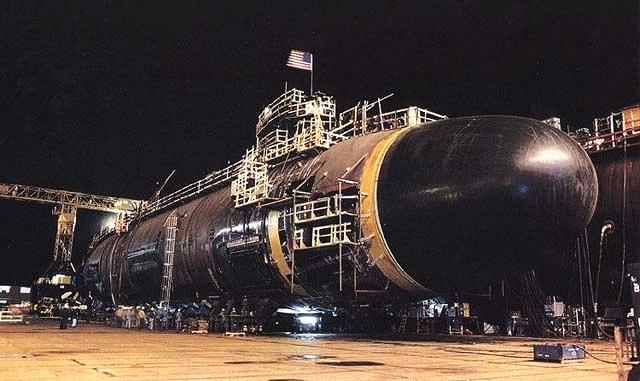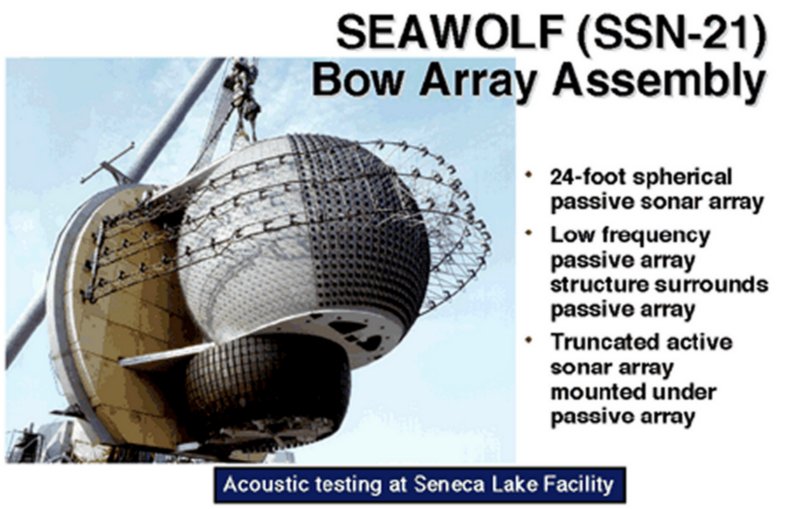Quietly tucked away in the Defense Authorization Act is a special appropriation of more than one-hundred million dollars to repair the damage done to the Seawolf-class submarine, USS Connecticut which struck a submerged object while operating in the South China Sea on the afternoon of October 3rd.
New images have emerged that offer some information as to the scope of the damage to the submarine and suggest why the repairs will cost so much. A statement made by Navy officials and sub’s Commanding Officer, Executive Officer, and Command Master Chief of the Boat all being relieved of their duties also gives an indication of what may have happened just prior to the collision.
The Seawolf-class is said to be the most advanced attack submarine in the US Navy and perhaps the world. It is also the most expensive submarine ever built by this country. Initially, twenty-nine ships in the class were ordered to be built with the first being delivered in 1989. By then, the cost had ballooned to an eye-popping $3.3 billion a copy which would amount to more than $7 billion in today’s valuation. Two of them would equal the cost of a Gerald Ford-class nuclear carrier today.
Perhaps the most important feature of a submarine is silent operations and the Seawolf-class is the quietest ever built. It is said that the sound signature of a Seawolf running submerged at twenty-five knots is less than that of a Los Angeles Class submarine tied up at the pier in port.
The end of the Cold War and Seawolf’s staggering cost ended up combining to limit the class to just three being built. One of which is the USS Connecticut. While designed as a hunter-killer of other submarines and surface ships, its stealth would also make it a very good spy vessel, relying on its stealth and on the relative lack of sophisticated anti-submarine warfare capabilities of countries like China in being undetected. In this role, the USS Connecticut would be able to locate and track Chinese subs and surface combatants to record their own sound signatures for later analysis. The sounds that ships and submarines are all unique, like fingerprints on a human. Recordings of various vessels stored by the computers that do acoustic processing aboard our own submarines and surface vessels can compare a vessel’s sound signature detected in real-time to its stored files and tell you which vessel or submarine you are listening to with a great deal of precision. Right down the Frigate having a slightly bent blade on one of its propellers.
This was most likely the mission of the USS Connecticut in October, to locate, track and classify vessels operating in the South China Sea, with an emphasis on ships and subs of the Peoples Liberation Army Navy or PLA Navy. With communist China seemingly launching new naval vessels every month, we would be very keen to get ears on them, so to speak.
In the course of this operation, Connecticut ran into a submerged object said to be a sea mount and badly damaged her bow and nose section housing her passive and active sonar arrays, but not breaching her pressure hull. To say the damage is extensive is not an understatement looking at these series of photos pulled from open sources on the internet.

In this photo, you can see the nose section cap which houses the primary sonar sensing systems of the submarine. These components are located outside of the pressure hull which protects the crew from the crushing pressure of deep operating depths. Torpedo tubes are not located in this section but are placed along the port and starboard sides of the hull. You can see their location in this image by looking at the two balcony-like scaffolds placed one over the other just behind the cap.

Inside that cap you would find the 24ft spherical passive sonar array, a low-frequency passive array, and a truncated active array. So what does all that do? The word “Passive” when applied to sonar means that it emits no signals and instead listens to sounds in the water. The spherical shape is full of hydrophones so sensitive that the computer can tell the operator where the sound source is in relation to the array, above it or below it, to the left or right and how far as well. The low-frequency passive array is a receiver for a long-range low-frequency active sonar emitter able to send a low-frequency “Ping” out to great distances and receive a return as well on submerged targets. Finally, the Active array contains sonar transmitters that are active, meaning they put sound out in the water. This array can be used for navigation to detect obstructions but is mostly for getting a very accurate bearing and distance to a sub or surface vessel just prior to launching a torpedo at it. Since the ping of an active sonar gives away the position of the submarine as well, it is not frequently used.
Already have an account? Sign In
Two ways to continue to read this article.
Subscribe
$1.99
every 4 weeks
- Unlimited access to all articles
- Support independent journalism
- Ad-free reading experience
Subscribe Now
Recurring Monthly. Cancel Anytime.
Now, look at this picture below which is a screen capture of the San Diego harbor webcam. The entire nose section is gone from the Connecticut. It was probably removed in Guam before the boat headed into San Diego and then to its homeport of Bremerton Washington.
That is pretty extensive damage. part of what that one-hundred million dollar plus repair bill is going to fix. A new nose and all the sonar gear inside of it. This is also a testament to how well the Seawolf class was built. It employed a modular design of at least eleven sections that can be replaced and constitute their own watertight spaces as well.
So what might have happened to bring this all about? There are three things that give us a pretty good idea.
In relieving the skipper, executive officer, and Chief of the Boat the commander of Naval Submarine Forces, Vice Admiral William Houston said, “We have very rigorous navigation safety procedures and they fell short of what our standard was,”.
He also ordered a thirty-day “Navigation Standdown” which didn’t put every sub back in port, but instead is a kind of pause for the Navy to remind all the sub skippers of what those rigorous navigation safety procedures actually are. The Navy tries very hard to put people in charge of submarines that are aggressive, sharp people with exceptionally good judgment skills. In wartime, they operate very much on their own with not much oversight over their actions at sea, so someone able to execute good judgment while operating independently is very important. They also need to be guys who don’t break important safety rules when no one is watching.
So, how does this come into play here?
The Dangerous Ground of the South China Sea
The South China Sea is a pretty unique body of water. In some places, it’s thousands of feet deep, and in other places waist-high. It an area of high volcanic activity dotted with islands and cays barely at sea level, submerged reefs, and atolls. These reefs can rise sharply from ocean depths of more than 3,000 feet. The bottom depth also changes with sea mounds rising from the bottom in months or a few years from seismic activity deep below.
There are ongoing attempts to chart these waters but it’s a pretty vast undertaking. As a result, some 52,000 nautical square miles of the South China Sea is referred to as “Dangerous Ground” to sailors navigating in these waters. That would include about eighty percent of the area you see on that map. The U.S. Geospatial-Intelligence Agency maritime advisory for these waters reads like this,
“Charted depths and their locations may present considerable error in the lesser-known regions of this area. Avoidance of Dangerous Ground is the mariner’s only assurance of safety.”
In other words, don’t even send a ship in there.
So, how do submarines navigate in these waters?
Very carefully
When a sub is operating on the surface it has a state-of-the-art global positioning system to nail down its location to within a couple of feet, but below the surface it’s blind. So it uses a computerized inertial guidance and navigation system that keeps track of every speed and course change and makes an educated guess as to where it is based on its last “fix” taken on the surface. It’s a very good system but it is not exactly precise and depends on regular fixes from the surface to adjust itself about every six days. The longer the boat goes without a new fix on its position the larger the error becomes: Feet become yards and yards become miles the longer the sub runs submerged. This isn’t a real problem between Hawaii and San Diego since it’s all pretty deep water between them, but it really matters in the South China Sea.
With this in mind, the Navy has some very detailed and particular rules of navigation in these waters that would include maximum operating depths, maximum speeds, and even areas of exclusion where they can’t go at all. The rules would also include how frequently the sub needs to “pop shallow” send up a buoy on a cable and get an updated navigation fix to keep an accurate sense of position on her charts.
When Admiral Houston mentioned that the Skipper, XO, and COB all fell short of the Navy’s “rigorous navigation safety procedures” it means that not only did the Skipper break these rules but his XO and COB probably knew about it and didn’t speak up. You see, the rules aren’t just binding on the commanding officer, but all his officers and senior enlisted men as well if they have anything to do with the safe navigation of the boat.
The actual error we may never know. It could have been something as simple as not updating the navigation fix as often as they were supposed to, or being too close to an off-limits area known for uncharted obstructions, but they did run into something and do more than $100 million dollars in damage to one of only three Seawolf-class submarines. The very best submarines we have. Damage that may take a year or more to repair. This submarine being out of action will mean either canceled deployments or extended deployments for other submarines trying to make up for the loss of Connecticut.
So it’s more than just the cost of repairs involved, there are operational issues that will impart a cost to the Navy as well.











